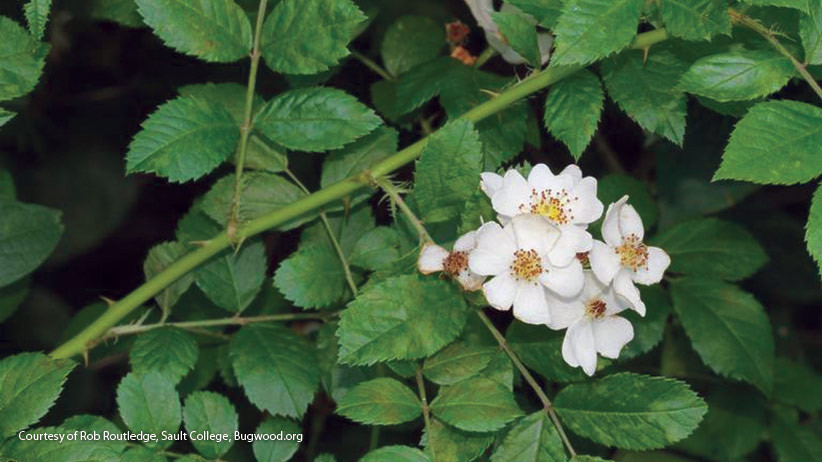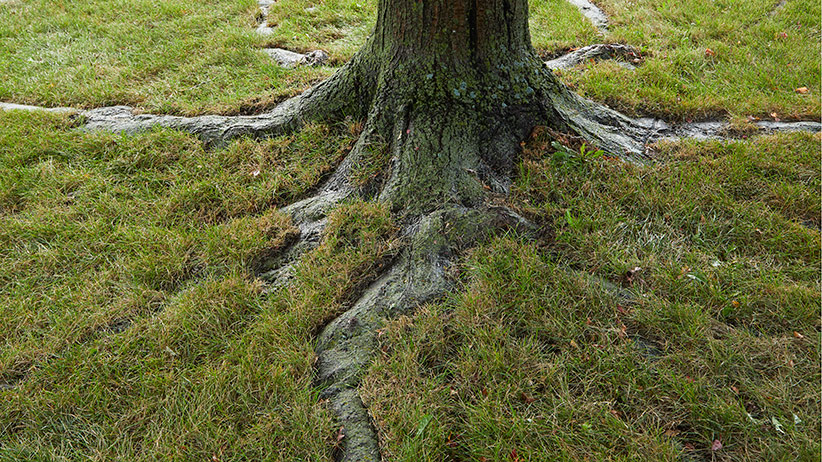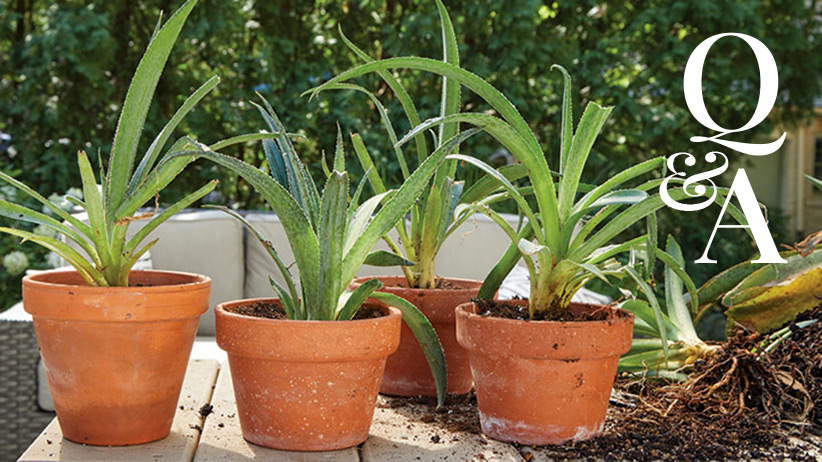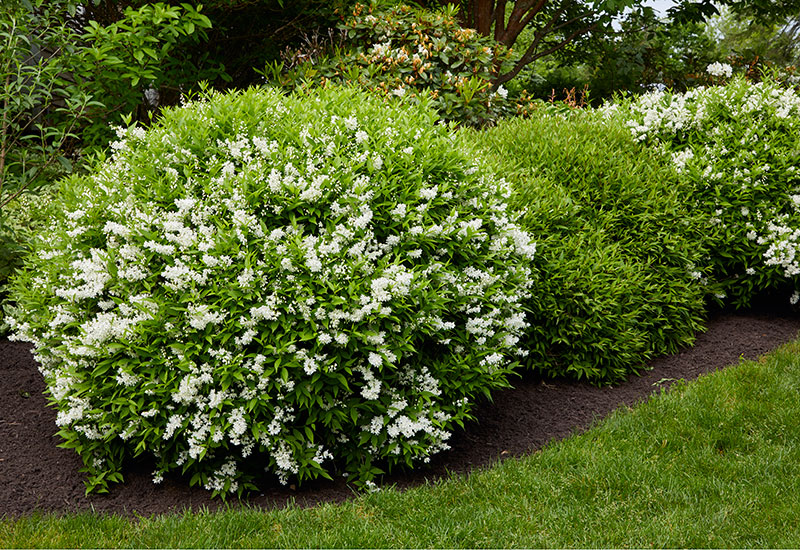
Pruning flowering shrubs to stimulate more blooms
If you want more color from your spring-blooming shrubs, start planning in spring while they are in flower. You may be surprised to find that pruning is the most effective way to stimulate your shrubs to bloom better, but you need to do it right after the flowers fade. Pruning can be a frightening task but you won't hurt your plants, not if you do it the right way. And this isn’t hard to do. Here's how to prune spring-flowering shrubs to encourage more and bigger blooms for next year.
Pruning timing is critical
Spring-flowering shrubs bloom on branches formed the year before. Don't prune in the early spring or you'll cut off this year's flowers. Wait until right after the flowers are spent because these shrubs need time to form the buds on new summer growth for next year’s flowers. If you cut too late, you’ll cut off those buds and miss out on the blooms for a year. And if you prune them back too much, you may lose the flowers for a year or so, too. But don’t worry, I’ve included illustrations showing you the simple pruning techniques to use.
You Might Also Like:
Pruning Spirea
5 Multiseason Shrubs
How to Prune Roses
DIY Spiral Topiary
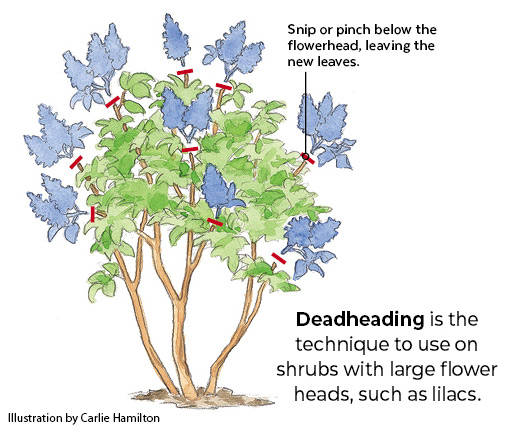
How to deadhead a shrub
Deadheading, which you see in the illustration above, means snipping off just the spent flowers. Often on a deciduous shrub, you can even see new leaves sprouting at the base of the dying flowerhead. This makes the decision of where to cut easy on shrubs with large flowers, such as lilac or viburnum.
Spring is also when you should deadhead evergreens, such as rhododendron and mountain laurel, but don’t take off too much. They are often slower growing than their deciduous counterparts and take more time to recover. With your fingers, grasp each spent cluster of flowers at the base and give it a twist to snap it off. Do it early in the day, before the sun wilts the stems, and you’ll find they come away easily.
Tools You Might Like for Deadheading
Compact Garden Shear
Mini-Pruning Shear
Straight Blade Pruning Snips
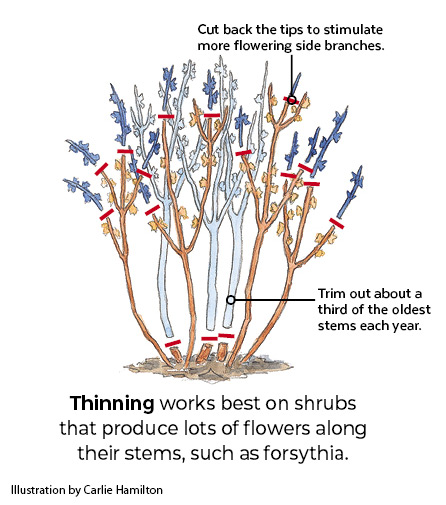
Tips for thinning spring-flowering shrubs
It would be very tough to deadhead all of the individual flowers on a forsythia, mockorange or deutzia. For shrubs like these, which have lots of small blossoms along the branches, trim back each stem tip after flowering to encourage more side branches and maintain the shape of the plant. Then remove a few of the older stems, cutting about a third of them down to within a few inches of the ground. The new stems that result from making these cuts will produce the best flowers over the next two to three years. As those stems mature, you take some of them out every year to make room for more new growth. This technique is called “thinning,” and you can see where to make cuts in the illustration above.
Tools You Might Like for Thinning Shrubs
Classic Hand Pruner
Bypass Pruner
Loppers
Guide to pruning spring-flowering shrubs
Pruning spring-flowering shrubs is that simple. Deadheading and thinning are the only two pruning techniques you need to know to get more flowers for the 38 shrubs featured in the chart below.
| Plant name Botanical name | Blooms | Deadhead or Thin | Tips |
|---|---|---|---|
| Almond, flowering Prunus glandulosa ‘Sinensis’ |
Pink; early spring | Thin | Thin half or more to produce more branches to keep the plant as dense as possible |
| Beautybush Kolkwitzia amabilis |
Pink, midspring | Thin | Thin every spring to help prevent this plant from growing ragged and leggy |
| Camelia Camellia japonica and hybrids |
Red, pink, white; early spring | Deadhead | Deadhead to keep the plant tidy, but don’t worry if you can’t reach them all; this shrub resents heavy pruning |
| Chokeberry Aronia spp. |
White; spring | Thin | Thin after blooming, however you’ll lose the colorful late-season fruit |
| Currant, clove Ribes odoratum |
Yellow; early spring | Thin | Thin no more than a third to maintain the height; does produce some fruit, but it’s not showy |
| Daphne Daphne xburkwoodii |
Pink; midspring | Deadhead or Thin | Remove dead wood first; shear lightly to deadhead and promote more flowering side branches |
| Deutzia Deutzia gracilis |
White; early spring | Thin | For a natural look, thin up to half of the branches; for a compact habit, cut all stems to the ground |
| Dogwood, cornelian cherry Cornus mas |
Yellow; early spring | Thin | Thinning lets you see the small flowers easier, but it does reduce the bright red fall fruit |
| Dogwood, redosier Cornus sericea |
White; late spring | Thin | Thin to maintain height and flowering; cut all stems to the ground for the most red winter stems |
| Forsythia Forsythia xintermedia |
Yellow; early spring | Thin | Cut a third to half of the old stems to the ground and shorten the rest each spring |
| Forsythia, white Abeliophyllum distichum |
White; early spring | Thin | Cut out up to half of the old wood each spring; in summer snip off a few tips to keep it looking tidy |
| Fothergilla Fothergilla gardenii |
White; midspring | Deadhead | Deadhead back to a side branch to develop a fuller, more compact habit |
| Fringeflower Loropetalum chinense |
Dark pink; midspring | Thin | Thin lightly to maintain natural form; prune the ends of all stems to promote a more compact habit |
| Gardenia Gardenia jasminoides |
White; mid- to late spring | Deadhead | Flowers often drop off clean, but pinch out spent blossoms to keep the plant tidy |
| Hawthorn, Indian Rhaphiolepis umbellata |
White; late spring to summer | Thin | Evergreen shrub needs only a light thinning to keep it tidy; black fruit hangs on through winter |
| Jetbead, black Rhodotypos scandens |
White; late spring | Thin | Loose, arching habit; thin after it flowers to keep the plant tidy, however you'll forfeit the black fruit |
| Kerria Kerria japonica |
Yellow; midspring | Thin | Thin to help keep this loosely branched shrub tidy; stems are bright green even in winter |
| Lilac, common Syringa vulgaris |
Purple, pink, red, white; midspring | Deadhead | Deadhead to keep tidy; thin up to a third of the stems every few years to reduce height |
| Mockorange Philadelphus hybrids |
White; late spring | Thin | Thin out stems that are two years old or more; shorten other stems to produce more side stems |
| Mountain laurel Kalmia latifolia |
Red, pink, white; spring | Deadhead | Evergreen; deadhead spent flowers; don’t thin more than third of the branches if you need to rejuvenate |
| Ninebark Physocarpus opulifolius |
Pale pink, white; late spring | Thin | Thin several of the oldest stems to the ground each year; snip a few tips to grow more side branches |
| Pea shrub Caragana arborescens |
Yellow; midspring | Thin | Thin out oldest wood to keep the shrub flowering and fresh looking; can also be sheared for size |
| Pearlbush Exochorda spp. and hybrids |
White; midspring | Thin | Thin up to half the stems to keep the loose form more dense and filled with flowers |
| Pieris, Japanese Pieris japonica |
White; spring | Deadhead | Evergreen; deadhead spent flowers to tidy the appearance |
| Privet, Japanese Ligustrum japonicum |
White; late spring | Thin | Thin this evergreen for a casual, informal look; can be sheared into a formal style |
| Pyracantha Pyracantha coccinea |
White; late spring | Thin | Thin or train as an espalier; too much pruning reduces the amount of colorful fall fruit |
| Quince, flowering Chaenomeles japonica |
Red, pink, white; midspring | Thin | Thin after flowering; cut back tips of branches in summer to promote new flowers |
| Rhododendron and Azaleas Rhododendron spp. and hybrids |
Pink, red, white; spring | Deadhead | Both evergreen and deciduous; deadhead; snip out errant stems at the same time to tidy the shape |
| Serviceberry Amelanchier spp. |
White; early spring | Thin | Thin only lightly or you’ll reduce the summer fruit |
| Spicebush Lindera benzoin |
Yellow; early spring | Thin | Thinning promotes more branches, but you will lose some of the bright red fall fruit |
| Spirea, baby's breath Spiraea thunbergii |
White; early to midspring | Thin | Thin up to half to maintain height, or cut all stems to the ground to rejuvenate each spring |
| Spirea, bridalwreath Spiraea prunifolia |
White; early to midspring | Thin | Thin out oldest stems and clip back other stems to promote more flowering side branches |
| Spirea, vanhoutte Spiraea xvanhouttei |
White; late-spring | Thin | Thin out up to a third of the oldest stems; snip off tall stems to force more side branches |
| Sweetshrub Calycanthus floridus |
Dark red; late-spring | Thin | Thin out a few of the oldest stems; to keep the shrub dense, also shorten back a few of the tips |
| Viburnum, doublefile Viburnum plicatum tomentosum |
White; midspring | Deadhead | Keep pruning to a minimum or you may ruin the layered habit this shrub is known for |
| Viburnum, Koreanspice Viburnum carlesii |
Pale pink; midspring | Deadhead | Deadhead back to a side branch; does produce fruit, but it's not showy |
| Winterhazel Corylopsis glabrescens |
Yellow; early spring | Thin | Rarely needs much pruning, but a light thinning of upper branches will show off the flowers better |
| Witchhazel Hamamelis xintermedia |
Yellow, orange; late winter to early spring | Thin | Rarely needs much pruning; remove suckers and do a light thinning to show off the flowers better |








